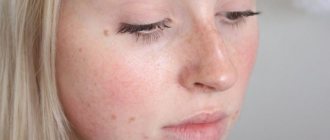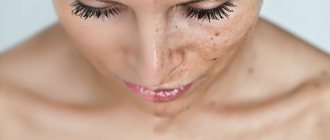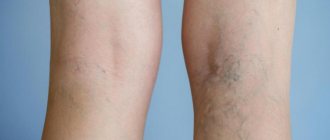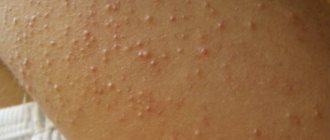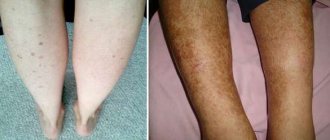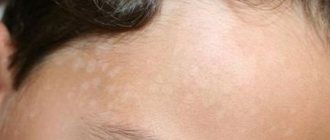The essence of the disease
Cases of pityriasis rosea are quite common, but at the same time, the disease itself has not been fully studied. Especially when it comes to the nature of emergence. Pityriasis rosea appears most often during periods when the immune system is weakened, in the autumn and spring. Often the disease is diagnosed after suffering from infectious diseases, hypothermia, problems with the gastrointestinal tract and other health problems. There are also cases where symptoms also appear as allergic reactions.
Pityriasis rosea, or Gibert's disease , is a dermatosis that is characterized by some structural nature of its course. There is a risk of exacerbations, as well as a risk of developing and intensifying allergies. Mostly, pityriasis rosea occurs in children over 2 years of age and adults under 40. In infants and older people, pityriasis rosea is extremely rarely diagnosed.
Most experts agree that pityriasis rosea is an infectious disease. There is a theory that means that it is caused by one of the types of viral herpes (VII or VI). But at the same time, the disease is not dangerous to others. If there is a patient with this diagnosis in a group of people, then there is no need to panic, since pityriasis rosea in most cases is not transmitted.
The main danger of pityriasis rosea is the wrong course of treatment, which can lead to serious complications, namely:
- severe irritation;
- severe allergic reactions that are difficult to treat.
That is why it is worth knowing and understanding the essence of the disease and being able to determine its manifestation in order to begin treatment in a timely manner. In the initial stages of development of pityriasis rosea, it is possible to get rid of it even at home.
During pregnancy
Pregnancy is a special condition for a woman; any previous illness, especially complications, can have a negative effect on the fetus. If the expectant mother gets sick with colds before 15 weeks, she should take care of other negative factors, as the risk of miscarriage increases. There is no need to panic and aggravate the situation: just observing a doctor and following his recommendations is enough.
In the later stages, the effect on the child is unlikely, but observation by a gynecologist and dermatologist is mandatory.
Causes
The studies carried out did not establish the only possible causative agent of the disease. But we were able to identify possible causes after which the symptoms of Zhiber’s disease are most often observed:
- stressful situations;
- hypothermia;
- periods of decreased immune defense;
- immunization through the administration of vaccines;
- avitaminosis;
- problems with the intestinal tract;
- infectious diseases;
- seasonal allergic reactions;
- insect bites that can be carriers of infection, for example, fleas, lice and others;
- disturbance of metabolic processes in the body.
It is not a fact that if these reasons are present, pityriasis rosea will necessarily appear, but the risk of developing symptoms of the disease increases.
Prognosis and prevention
Since it has not yet been possible to identify the causative agent of Zhiber's disease, prevention is of a general nature. Doctors recommend:
- Dress appropriately for the weather and avoid hypothermia.
- Treat viral infections promptly and completely. After recovery, take a course of vitamin therapy.
- If you cannot avoid stressful situations, take sedatives to prevent possible complications.
- Constantly support your immune system: eat protein foods, walk in the fresh air, play sports, and exercise.
- Observe personal hygiene rules.
- Eat right and minimize the consumption of foods with preservatives.
Pityriasis rosea does not cause dangerous complications and does not have a negative effect on the body as a whole, so treatment prognosis is always favorable. Even if you do not use drug therapy, Zhiber's disease will go away on its own over time, and the patient will acquire stable immunity and will never suffer from characteristic skin reactions.
Symptoms
A characteristic sign of the disease is rashes on the body. Pityriasis rosea can appear on all parts of the skin. Many patients experience pain in the joints, general weakness, and a headache before a profuse rash occurs. Often there is even an increase in lymph nodes in the neck.
In the video, the dermatologist will describe in detail the symptoms of the disease, indicating where the disease begins and the main development processes.
An indicative sign of pityriasis rosea are small pink spots. They quickly spread throughout the body and increase in size. The main parts where rashes appear are:
- torso;
- arms and legs;
- cervical region;
- front part of the head;
- hands and feet, especially with severe sweating.
The spots are most likely to appear on the torso, back and chest.
Rashes appear from time to time. You can recognize them by their characteristic oval shape. They reach up to 3 cm in diameter. The spots in most cases itch, causing discomfort. A few days after the appearance of the rashes, they change their appearance, namely:
- the middle of the spot sinks a little (the central part is covered with folded scales, and a pink border is formed along the edges, without peeling);
- the skin becomes brown;
- keratinized scales appear on top of the spot;
- the edges of the rash rise slightly and peel.
When the peeling goes away, a small strip of stratum corneum remains around the brown center. In other places the color remains pink.
Good to know! During pityriasis rosea, several types of rashes may simultaneously appear on the body.
An important sign of the onset of development of pityriasis rosea is the fact that a week or two before the onset of a profuse rash, the first spot already appears in more than half of patients. It is called maternal. It is initially larger than usual and can reach 4 cm in diameter. In addition, it peels off over the entire surface. Often, before the appearance of rashes, patients may experience general malaise and fever.
The general period of the disease is 1-2 months, after which traces in the form of pigmentation may still be observed. Usually this disease does not recur, but in case of severe weakening of the immune system, a relapse (resumption of the disease) is possible.
Diagnostics
To establish a diagnosis, a general examination is performed, focusing on the spots. But often, rashes with pityriasis rosea can resemble other dermatological diseases. For example, it could be rubella, measles, psoriasis or others. To accurately establish a diagnosis, it is recommended to carry out a number of procedures:
- study of a general blood test;
- study of general urine analysis;
- scraping;
- performing a serological test.
It is the overall result that will make it possible to establish that the spots that have appeared are definitely manifestations of pityriasis rosea.
Treatment
Treatment of pityriasis rosea (Giber's disease) is not difficult. When identifying the corresponding stains, there is no need to worry too much. For many, the rash goes away without any additional medications in 4-6 weeks. Some time after recovery, small spots may still remain on the skin in the places where the disease manifests itself; they will also disappear in 2-3 weeks.
But there are some rules that should be followed to speed up the process of getting rid of lichen, namely:
- minimize water procedures, switch to taking a shower instead of spending a long time in the bathroom;
- for washing, use products that do not dry the skin; it is better to take something from the series for children;
- try to wear clothes exclusively made from natural fabrics, as synthetics can activate inflammatory processes on the skin;
- minimize physical activity in order to prevent overheating, as well as excessive sweating;
- adhere to proper nutrition (dairy products, lean meat, such as chicken), give up bad habits (alcohol, smoking).
If, after 6-8 weeks, pityriasis rosea does not go away, you should consult a dermatologist, since untimely treatment can lead to complications of infection of areas with rashes. In such cases, the doctor prescribes antibiotics to prevent the occurrence of eczema.
Medications against pityriasis rosea
But rashes do not always go unnoticed. Often the patient feels itching. To reduce the feeling of discomfort, it is recommended to use antiallergic drugs, among which the most popular are:
- Loratadine;
- Suprastin;
- Erius;
- Eden;
- Tavegil and others.
Acute manifestations of dermatosis require the use of antibacterial drugs. With this diagnosis, Erythromycin is recommended, which will stop the development of the disease and relieve acute attacks.
At the same time, it is worth taking medications to strengthen the immune system. These include:
- vitamin complexes (Vitrum, Complivit and others);
- immunostimulant preparations made from natural ingredients (schisandra or echinacea).
But it is worth remembering that all medications are recommended to be taken only in cases of acute manifestations of the disease, when the body is not able to cope with the symptoms on its own.
Treatment with ointments
When pityriasis rosea does not go away within a month or causes severe discomfort to the patient, there is a group of antibiotics or corticosteroids in the form of ointments that are prescribed for treatment. These include:
- Flucinar – an ointment with anti-allergenic properties, belongs to the group of hormonal drugs. It relieves itching, and also removes flaking, improves skin color;
- Sinalar – an ointment that combines an antibacterial effect and also contains glucocorticoid drugs that quickly relieve itching, stop inflammatory processes, and significantly improve the skin in areas of rash;
- Lorinden A – steroid ointment, which contains salicylic acid. With its help you can relieve itching, remove swelling, and reduce peeling.
The group of ointments against pityriasis rosea also includes the Tsindol suspension. It contains zinc, which regenerates the skin well, relieves swelling and itching, and stops inflammation. It is necessary to wipe the rashes 1-2 times a day.
The following drugs are also recommended for topical use:
- Salicylic alcohol;
- Resorcinol solution.
They are excellent antiseptics, which helps stop the development of lichen. They should be used to wipe the rashes several times a day, but not less than three.
Attention! You should use alcohol, iodine, lotions and other similar drugs very carefully and in rare cases. They can increase the unpleasant sensation of itching and also dry out the skin very much.
Folk remedies
Traditional medicine tips can also help in the treatment of pityriasis rosea. Before using traditional methods, it is better to consult a dermatologist. Self-medication can lead to complications, as well as infection of healthy areas of the skin.
The most popular folk remedies against dermatosis of this type are:
- pour vodka over celandine leaves, leave for at least 20 days, then drink half a teaspoon each time before meals;
- lotions from a tincture of a plant such as golden mustache. They must be done daily. You can buy the mixture at the pharmacy, but it is better to prepare it yourself by grinding the fresh leaves of the plant into a paste.
- Apply calendula ointment 3 times a day to the areas of manifestation of the disease. You can buy it at the pharmacy or prepare it from 10 grams of leaves and 50 grams of petroleum jelly, which are mixed after grinding the calendula.
- drinking aloe juice, which must be squeezed directly from the plant’s sills. It should be drunk 1 tablespoon for 2 weeks before meals.
- Apply the remains of burning paper to the rashes. A kind of paper “resin” can be obtained by burning a paper cone on a plate.
All traditional medicine recipes are quite simple and accessible, but they have a higher risk of aggravating the situation, so they must be used with extreme caution.
An excerpt characterizing Pityriasis rosea
- Ah, mon ami, oubliez les torts qu'on a pu avoir envers vous, pensez que c'est votre pere... peut etre a l'agonie. – She sighed. – Je vous ai tout de suite aime comme mon fils. Fiez vous a moi, Pierre. Je n'oublirai pas vos interets. [Forget, my friend, what was wronged against you. Remember that this is your father... Maybe in agony. I immediately loved you like a son. Trust me, Pierre. I will not forget your interests.] Pierre did not understand anything; again it seemed to him even more strongly that all this should be so, and he obediently followed Anna Mikhailovna, who was already opening the door. The door opened into the front and back. An old servant of the princesses sat in the corner and knitted a stocking. Pierre had never been to this half, did not even imagine the existence of such chambers. Anna Mikhailovna asked the girl who was ahead of them, with a decanter on a tray (calling her sweet and darling) about the health of the princesses and dragged Pierre further along the stone corridor. From the corridor, the first door to the left led to the princesses' living rooms. The maid, with the decanter, in a hurry (as everything was done in a hurry at that moment in this house) did not close the door, and Pierre and Anna Mikhailovna, passing by, involuntarily looked into the room where the eldest princess and Prince Vasily. Seeing those passing by, Prince Vasily made an impatient movement and leaned back; The princess jumped up and with a desperate gesture slammed the door with all her might, closing it. This gesture was so unlike the princess’s usual calmness, the fear expressed on Prince Vasily’s face was so uncharacteristic of his importance that Pierre stopped, questioningly, through his glasses, looked at his leader. Anna Mikhailovna did not express surprise, she only smiled slightly and sighed, as if showing that she had expected all this. “Soyez homme, mon ami, c'est moi qui veillerai a vos interets, [Be a man, my friend, I will look after your interests.],” she said in response to his gaze and walked even faster down the corridor. Pierre did not understand what the matter was, and even less what veiller a vos interets meant, [to look after your interests,] but he understood that all this should be so. They walked through the corridor into a dimly lit hall adjacent to the count's reception room. It was one of those cold and luxurious rooms that Pierre knew from the front porch. But even in this room, in the middle, there was an empty bathtub and water was spilled on the carpet. A servant and a clerk with a censer came out to meet them on tiptoe, not paying attention to them. They entered a reception room familiar to Pierre with two Italian windows, access to the winter garden, with a large bust and a full-length portrait of Catherine. All the same people, in almost the same positions, sat whispering in the waiting room. Everyone fell silent and looked back at Anna Mikhailovna who had entered, with her tear-stained, pale face, and at the fat, big Pierre, who, with his head down, obediently followed her. Anna Mikhailovna's face expressed the consciousness that the decisive moment had arrived; She, with the manner of a businesslike St. Petersburg lady, entered the room, not letting Pierre go, even bolder than in the morning. She felt that since she was leading the one whom the dying man wanted to see, her reception was guaranteed. Having quickly glanced at everyone who was in the room, and noticing the count's confessor, she, not only bending over, but suddenly becoming smaller in stature, swam up to the confessor with a shallow amble and respectfully accepted the blessing of one, then another clergyman.
Diet for pityriasis rosea
Treatment of pityriasis rosea also requires compliance with nutritional rules, namely, it is necessary to eat exclusively dietary foods that belong to the hypoallergenic group.
These are:
- all fermented milk products;
- lean meats: beef, chicken;
- cod;
- wholemeal bread;
- cereals: rice, pearl barley, oatmeal;
- vegetables of dull colors;
- vegetable oils;
- drying, prunes, dried apricots;
- still mineral water, dried compote, tea, rosehip drink;
- tongue, kidneys, liver;
- sea bass.
Not often, but the following products are allowed:
- cereals: buckwheat and corn;
- pork, lamb, rabbit, but not fatty parts;
- potato;
- legumes;
- herbal decoctions.
The following are strictly not permitted:
- seafood, caviar;
- citrus;
- spices;
- conservation;
- eggs;
- brightly colored fruits and vegetables;
- soda;
- alcoholic drinks;
- dried fruits;
- honey;
- nuts;
- cocoa, chocolate;
- coffee;
- products with emulsifiers, dyes.
It is recommended to adhere to this type of diet for 2 weeks, although children only need to adhere to it for a week.
Preventive precautions
The best treatment for a disease is prevention. In order to avoid the manifestations of depriving Zhiber, it is worth taking a number of preventive actions, namely:
- avoid changes in the temperature of the external environment in which you are located, in particular, you should not overcool;
- treat all infectious diseases to the end, take vitamin complexes after them;
- Avoid stressful situations as much as possible or take sedatives;
- exercise, take medications to strengthen the immune system;
- carefully monitor personal hygiene;
- Avoid dyes, preservatives, flavors, and chemical additives as much as possible.
It is also worth noting that after suffering the disease once, a person gains immunity against pityriasis rosea. Re-infection is very rare.
Incubation period and developmental stages
The described disease is of an infectious-allergic nature. Its incubation period is short, the first plaques appear on the human body 2–20 days after infection. With good immunity, pityriasis rosea goes away on its own within eight weeks; if there are health problems, it lasts up to six months.
Nonspecific forms of the disease require drug treatment. Two stages of development are recorded: identification of the maternal plaque and spread of the rash throughout the body. When numerous rashes appear, the course of Zhiber's disease becomes cyclical. In this case, it is not possible to distinguish stages. If pityriasis rosea does not go away after six months, you should seek help from a dermatologist.

